The elevator system uses a fast loop to enhance the movement speed of the working components without increasing the hydraulic pump’s output flow. This is achieved by altering the effective working area of the hydraulic cylinder. Each elevator product comes with a detailed manual, and it's crucial for users to thoroughly read and follow the instructions before operation. One important consideration is selecting the appropriate reversing valve and tubing for the differential oil circuit based on the flow rate during differential operation. If not properly chosen, excessive flow resistance may occur, causing some hydraulic fluid to return through the overflow valve to the tank, which can slow down the system and make it ineffective.
In most elevator systems, only a few electrical components are involved, such as the power control box, power unit, and wiring connected to the lifting arm. If the elevator is used outdoors, especially in harsh weather conditions like rain or snow, it's recommended to protect the power control box and the external parts of the power unit. During summer, avoid exposing the wiring to extreme heat to prevent damage or breakage. Since the lifting equipment is typically conductive, any electrical leakage should be treated with caution. Non-technical personnel should never attempt to touch or inspect the system. In case of a leak, the external power supply must be immediately disconnected to ensure personal safety. All maintenance work, particularly those involving electrical components, should be performed by certified professionals.
The system also allows for switching between fast and slow motion, with the fast movement utilizing a differentially connected circuit. When the electromagnet at the left end of the reversing valve is activated, the valve shifts to the left position, allowing pressure oil from the hydraulic pump and the oil in the right chamber of the cylinder to flow into the left chamber via the left and lower ports, creating a differential connection. This enables the piston to move rapidly to the right. Once the fast movement ends and the mechanical stop on the working part activates the reversing valve, the pump pressure increases, opening the valve. At this point, the return oil from the right chamber can only flow back to the tank through the speed control valve. When the electromagnet at the right end of the reversing valve is energized, the piston retracts quickly to the left. Although this method of using a differential connection is simple and cost-effective, the transition between fast and slow speeds is not always smooth.

Mild steel, sometimes referred to as carbon steel or ordinary carbon steel, is defined as having a carbon content of no more than 2% and no other perceptible alloy elements.
This steel is produced on a large scale and is the largest part of the steel production industry. You will be able to find it in various applications, fasteners and fasteners.
Generally, this kind of steel has high strength, high hardness and magnetism, and is usually used in motors and electrical appliances - however, their corrosion resistance is poor, and should not be used in corrosive environment without protective coating or coating.
There are some differences between low-carbon steel and steel, because steel has lower toughness and greater brittleness, and low-carbon steel can be further strengthened by adding carbon.
If you need more information or want to order carbon steel products, such as hexagon Bolts, carriage bolts, flange bolts, U-bolts, union bolts, expansion bolts, threaded rods, please contact us.
Carbon Steel Bolts,High Carbon Steel Bolts,Bolt Carbon Steel,Carbon Steel Fasteners
Taizhou Hongchuang Hardware Co., Ltd. , https://www.taizhouhongchuang.com